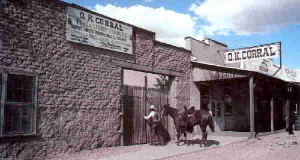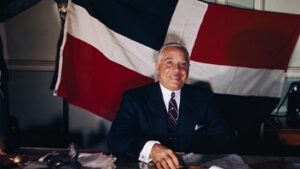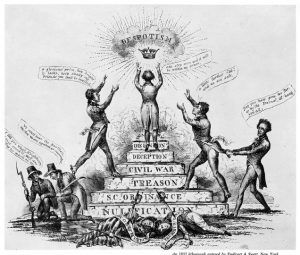It’s a quite October morning in 1881 in a small mining town in Arizona, when suddenly the sound of gunshots fills the air; two shots, then a pause, the town goes silent and just as quickly as the pause began, it’s filled with gunfire once more. You and everyone in town race to find the source and what do you find? You find seven men in an open lot, three dead, three seriously wounded, and one man standing tall without a single scratch on him. What happened? Who are these men? How did such a conflict occur? To the people in Tombstone, this was a very real event; some thought that it was just another gunfight, but little did they know that it wasn’t, but rather a fight that tells a story. It’s the story of three brothers and a friend who moved into a town looking for the opportunity for a better life, but they ended up facing outlaws who threatened their lives. Little did the people of Tombstone know that they had just witnessed the fight that would soon go down in history as one of the most famous gunfights of all time.

Wyatt Earp moved to Tombstone in the winter of 1879, along with his wife Mattie and his brothers James, Virgil, Morgan, and Warren. All of the Earp brothers moved to Tombstone in the hopes of becoming wealthy, and climb the social ladder there quickly.1 Within a year of living in Tombstone, Virgil Earp was appointed the town’s Marshal, and Wyatt often acted as a deputy. Wyatt Earp also worked as a guard in the Oriental Saloon.2 The Earp brothers became successful businessmen in the town, and began to make a name for themselves. As part of the law enforcement for the town, they also began to make enemies.
Tensions rose as cowboys started to make trouble in Tombstone by robbing stagecoaches, rustling cattle, and gun fighting. Wyatt Earp attempted to make a deal with Ike Clanton in order to bring in three of these fugitives–Bill Leonard, Harry Head, and Jim Crane–all accused of robbing a stagecoach and killing a man. Earp knew that if he managed to capture these fugitives, his chances of becoming sheriff would greatly increase. Ike Clanton was willing to make the deal; however, before the deal could be affirmed, the fugitives were killed by another group of outlaws.3 Ike Clanton became concerned that word would get back to the cowboys about his “almost” deal with Wyatt Earp.
Due to his paranoia, Ike accused Wyatt of telling his good friend Doc Holiday about the deal that he almost made with Wyatt. Wyatt told Ike that he didn’t tell anyone about the deal, but Ike stormed off, and later that night came face to face with Doc Holiday. While gambling in a saloon, Clanton and Holiday got into a heated, drunken argument, where Holiday called Clanton “a damned liar who threatened the Earp’s,” to which Ike responded with “pull out your gun and get to fighting.”4 Both Clanton and Holiday were ready for a fight; however, before the situation could escalate, Wyatt and Virgil Earp stepped in to calm the situation down.
Later that night Ike Clanton went from saloon to saloon drinking, gambling, and making threats against the Earp family and Doc Holiday, claiming that he was going to gun them all down the next morning. Later that night he was arrested by Virgil Earp for carrying a firearm in town. He was forced to spend the night in jail and was fined $25. Little did the Earp brothers know that the next day would be one that would go down in history.5
On the morning of October 26, 1881 while attempting to retrieve Ike from jail, Tom McLaury and Wyatt Earp got into a heated argument, which resulted in Tom getting slapped with Wyatt’s pistol. Frank McLaury and Billy Clanton rode into Tombstone and heard what has happened to their brothers. They became angry and went to purchase guns. The small group of cowboys began going around town and making threats towards the Earp brothers and Doc Holiday. They made their way up Freemont Street, through town, and then settled in the O.K. Corral.
Word spread quickly of the threats, which were not taken lightly by the Earp’s and Holiday. They felt that enough was enough and something had done about the cowboys. As marshal of Tombstone, Virgil Earp made the decision to go down to the O.K. Corral along with his two brothers Morgan and Wyatt, and disarm the cowboys. Doc Holiday approached the three brothers and agreed to assist them. Virgil began walking with a shotgun in hand, and Wyatt suggested that in order to prevent things from escalating, Virgil should give the shotgun to Holiday. Virgil agreed and handed the shotgun to Holiday, who hid the shotgun under his long trench coat and in turn handed his walking stick to Virgil to carry. Wyatt Earp had a six shooter on his hip, which he decided to place in his back pocket to keep it out of sight.6

While walking towards the O.K. Corral they were approached by Sheriff John Behan. Virgil informed the sheriff that he did not intend to start a fight with the cowboys, but he only intended to disarm them, due to the fact that they were carrying guns within the town limits. Sheriff Behan pleaded with them not to go down there. He claimed that if they went down there, they would only “get themselves murdered.” He then insisted that Virgil let him go down to the O.K. Corral and try to talk some sense into them, and Virgil agreed. Behan returned after twenty minutes and told Virgil that he had “disarmed them.” At that same moment, Virgil and his brothers, along with Doc Holiday, made their way to the O.K. Corral to arrest them.7
When they arrived at the O.K. Corral, they discovered that the sheriff had in fact not disarmed them. Both Frank McLaury and Billy Clanton had a revolver on their person and a shotgun strapped onto their saddles. When Virgil approached, he yelled “throw your hands up boys, I intend to disarm you.” At that same moment, guns were drawn, and suddenly the sound of gunfire filled the streets of Tombstone. There were two shots and a then a short pause, and just like that, the gunfight had begun.8
It is unclear who fired the first two shots, but those were followed by many. Doc Holiday fired his shotgun, hitting Tom McLaury in the chest killing him. Ike Clanton lurched at Wyatt screaming that he didn’t have a gun, and Wyatt threw Ike to the side and responded with the famous line “the fighin’s commenced. Either get to fightin or get away,” and with that Ike Clanton ran. Morgan Earp was shot in the shoulder by Billy Clanton, who was then shot in the chest and killed. Frank McLaury, who was badly wounded, shot Virgil in the calf then crumpled to the ground. He quickly rose when Doc Holiday approached. He stood and said “I’ve got you now.,” to which Holiday responded, “blaze away. You’re a daisy if you do.” Frank fired and hit Holiday in the side. As Frank tried to escape, both Holiday and Morgan Earp took a shot, Holiday hitting him in the chest and Earp’s shot hitting him in the head.9
Then suddenly everything went quiet, and the fight was over. Sheriff Behan approached the brothers and attempted to arrest Wyatt Earp and Doc Holiday, but Earp looked at the sheriff and said “I won’t be arrested. You deceived me, Johnny, you told me they were not armed. I won’t be arrested, but I am here to answer what I have done. I am not going to leave town.”
https://www.youtube.com/watch?v=eIpVWTZYWr8
When the dust settled, journalists began to swarm the scene to get the story that would soon go down in history. Journalist Richard Rule was one of the first on scene and was soon followed by his rivals from the Tombstone Epitaph. Both reports were in favor of the Earp brothers and Doc Holiday, who claimed they only shot in response to the cowboys reaching and firing their guns. However, Ike Clanton had a very different story to tell. After the fight, he quickly filed murder charges against the Earps’, which led to the arrest of Wyatt Earp and Doc Holiday, and led to what would be known as the Spicer Hearing.10

Ike Clanton claimed that Wyatt Earp fired the first shot, and that his brother had his hands up and was shot in cold blood. The prosecution had several witnesses that claimed that his version was the true story, including Wesley Fuller, Billy Allen, and Billy Claiborne, all claiming that Tom McLaury was unarmed when he was shot. These witnesses were able to offer good testimony in favor of the prosecution; however, the most important witness that they had was none other than Sheriff Behan. Behan claimed that Doc Holiday took the first shot, and that the Earp/Holiday party shot at unarmed, surrendering cowboys; however, Wyatt and Virgil Earp both offered up a very different story.
In the version of the Wyatt and Virgil Earp, once they reached the O.K. Corral, Billy Clanton and Frank McLaury both reached for their six-shooters, and Virgil called out “Hold, I don’t mean that, I mean to disarm you.” Wyatt Earp said that when he saw them draw their guns, he drew his gun. Then Wyatt said that Billy Clanton took the first shot and he himself the second as a response.11 The story told by the two Earp brothers was one that matched with the story in the Tombstone Daily Nugget, which also claimed that the cowboys reached for their guns and Earp merely responded. Virgil Earp gave testimony that after the fight, Behan himself came up to him and said “you’ve just done right.” This testimony, along with the article in the Daily Nugget, made people question Behan’s credibility. The Pre-trial ended December 1, 1881 with Judge Spicer ruling that there was not enough evidence to convict Wyatt Earp or Doc Holiday of any wrong doing.
The Gunfight at the O.K. Corral became legendary, and defined the lives of those involved, especially the Earp Brothers and Doc Holiday. The Earp brothers gained a strong, heroic reputation for their actions that day. Although many would think this fight would end the feud between the cowboys and the Earps, it did exactly the opposite. After the O.K. Corral, the cowboys were out for blood, and would eventually go after all of the Earp’s. Morgan Earp was later shot and killed in Tombstone, and Virgil Earp survived an assassination attempt. After the death of his brother Morgan, Wyatt made an oath to his brothers that he would hunt down and kill all the men who went after his family.12
Many stories have surfaced claiming to know what really happened on that fateful October day in 1881. Some claim that Billy Clanton and the McLaury brothers were shot and killed in cold blood, and others say that the Earp Brothers and Doc Holiday were simply defending themselves. The town of Tombstone would later gain the name “the town too tough to die.” Today in Tombstone, long after all the guns and gangs have been removed, the O.K. Corral still stands as a strong reminder of the gunfight that would make the town of Tombstone famous.
- William B. Shillingberg, Tombstone, A.T. : A History of Early Mining, Milling, and Mayhem (University of Oklahoma Press, 2016), 134-138. ↵
- Western Expansion Reference Library, 200, s.v. “Wyatt Earp,” by Allison McNeill. ↵
- Sean McLachlan, “Grudge match at the O.K Corral: for the Earps, Clantons, and McLaurys, the Civil War never really ended,” America’s Civil War 27, no.1 (2014): 49. ↵
- Jeff Morey and Casey Tefertiller, “O.K Corral: A Gunfight Shrouded in Mystery,” Wild West 14, no.3 (2001): 38. ↵
- Shillingberg, Wm. B. Tombstone, A.T. : A History of Early Mining, Milling, and Mayhem (University of Oklahoma Press, 2016), 140-141. ↵
- Allen Barra, Inventing Wyatt Earp: his life and many legends (New York: Carroll and Graft, 1998), 61-72. ↵
- Jeff Morey and Casey Tefertiller, “O.K Corral: A Gunfight Shrouded in Mystery,” Wild West 14, no.3 (2001): 38. ↵
- “The Story: Yesterday’s Tragedy,” The Tombstone Epitaph , Oct. 1881. ↵
- Jeff Morey and Casey Tefertiller, “O.K. Corral: A Gunfight Shrouded in Mystery,” Wild West 14, no.3 (2001): 38. ↵
- Bob Cash and Casey Tefertiller, “ Finding Wyatt,” Wild West 30, no.3 (October 2017): 38. ↵
- “The Story: Yesterday’s Tragedy,” The Tombstone Epitaph, Oct. 1881. ↵
- Bob Cash and Casey Tefertiller, “ Finding Wyatt” Wild West 30, no.3 (October 2017): 38. ↵



55 comments
Ernie Sano
When it comes to the Wild West, few pieces can portray an accurate depiction of the reality of living in the Wild West. I think you did a pretty great job painting the scene of Wyatt Earp and the harshness of living in a dangerous time. You included plenty of detail without losing the focus of your article and you were very entertaining in those details that makes this a fun article to read!
Alejandra Chavez
I managed to find a typo in the first sentence where the writer had meant to put “quiet” but put “quite”. Anywho, I found this article to be very informative and very grounding. Society has romanticized the wild west when in fact, it was a very devastating and deadly issue. I find it amazing how people would rather die for their beliefs than have an open mind. Great article.
Michael Mandujano
The author produced a well-written article on The Gunfight at the O.K Corral. After reading this article I gained a greater knowledge of the cowboys and outlaws scheme during the 18th century. I find it amusing how these gun showdowns were considered popular. In fact, the title of the article was very clever. Overall, this was a well-structured article and I enjoyed the images throughout the article, especially the Youtube video that was included.
Deanna Lummus
This article kept my attention till the end. I have always been interested in old westerns and this gave great insight into what is was really like leading up to a such a well known gun fight. The structure and timeline provided in this article made it easy to read and I appreciated the realness that it provided. It shows that it wasn’t all a good time with big strong men with guns defending his ladies’ honor, but yet something extremely dangerous and most of the time fatal.
Angela Rodriguez
This was definitely an interesting article to read, I actually have some family members that live in Arizona. While I have never heard about the famous gunfight that occurred in Tombstone, but I have seen one or two movies in relation to the Wild West. I’m not surprised that in the movies the Wild West was portrayed a certain way compared to what life was really like. It’s still great to hear that these men still take pride in their town.
Alexis Renteria
Reading your article made me feel like I was watching a movie on the wild west. It was interesting reading about how the Earp brothers came into the town to try and climb the social ladder but in doing so caused problems which led to an all out shoot out. I liked that you did not only include one side of the story and what happened based on witness accounts proving Ike Clantons statement true with the sheriff backing it up but you also included the Earp brothers version. Overall, I really enjoyed reading this article and learning about the shoot out in the O.K Corral
Mario Sosa
What an engaging article! I had not heard about the gunfight at Tombstone, so I was fascinated all throughout the article. It does not surprise me that there have been films that cover this event and many others that are inspired by the conflict at Tombstone. Like others, I do think it is important that people are aware that the Wild West was more dangerous than it was fun. Superb job.
Edith De Loera
I find it interesting how their are still controversies til this day, about whether or not the brothers were killed. This article provided me with great insight on a topic I do not have much knowledge of. You showed a swell job of depicting how not so fun the wild west times were back then. I also enjoyed your clip of the officer, seeing as it gave me a more graphic approach to the story.
Joshua Breard
For some reason, there always seems to be romanticism when talking about the Wild West. Many Wild West movies contribute to the culture of saloons, bar fights, and men protecting their honor. The end of the day, the Wild West is in the desert with conditions that can be unbearable. So to say that living in the Wild West looks fun, it really was not that fun of a time. Great article!
Crystalrose Quintero
This article was a particularly interesting read because it takes place in my native state of Arizona. I very much enjoyed the video they had to offer showing how the gunfight had gone. I also appreciated that the article concluded by stating that today there are mixed feelings about whether the brothers were murdered or were killed simply as a result from self defense.